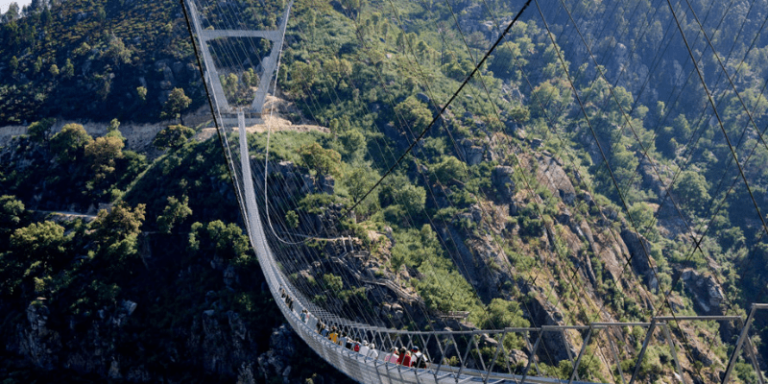The Spill: A Long Hike and Amazing Views
Weekly news you can use.
By: GenZ Staff | May 6, 2021 | 786 Words

(Photo by Horacio Villalobos#Corbis/Corbis via Getty Images)
Portugal’s Heart-Pounding Pedestrian Suspension Bridge
It’s 1,693 feet long, has a footpath wide enough for two people, and is 576 feet above the Paiva River in Arouca, Portugal. It is officially the world’s largest pedestrian bridge, and it takes about ten minutes to cross. The bridge crosses a gorge in the Arouca Geopark. The span features views of lush greenery, waterfalls, and the swift currents of the river below. Steel cable construction and a see-through metal grid walkway gives travelers the best possible views.
Arouca is a small area with an aging population: Many young people are moving into the cities. Locals believe this bridge will bring new interest to the area and boost the struggling post-pandemic economy with much-needed investment in local business with additional tourism.
 Local Arouca residents were given the first chance to cross the bridge. Hugo Xavier was the first to do so, but he was soon followed by other locals. As Xavier reached the other side, he said: “I was a little afraid, but it was so worth it. It was extraordinary, a unique experience, an adrenaline rush.”
Local Arouca residents were given the first chance to cross the bridge. Hugo Xavier was the first to do so, but he was soon followed by other locals. As Xavier reached the other side, he said: “I was a little afraid, but it was so worth it. It was extraordinary, a unique experience, an adrenaline rush.”
Switzerland was the previous record holder in pedestrian suspension crossings with the Charles Kuonen Suspension Bridge. It’s 1,621 feet long and has incredible views of the Alps. In the United States, Gatlinburg, TN, has a 680-foot Sky Bridge. But the most famous pedestrian suspension bridge in America crosses the iconic Royal Gorge in Colorado; it’s 956 feet above the Arkansas River and is 1,260 ft in length.
Addressing a Joint Session
The long-anticipated national speech in front of members of Congress revealed the Biden administration’s goals and objectives. A small gathering of U.S. senators and representatives sat in the House chambers to hear what Mr. Biden had accomplished in his nearly 100 days in office. Joining the president on the dais was Vice President Kamala Harris and House Speaker Nancy Pelosi.
The president claimed he had the highest job increase of any president in the first 100 days of office and talked about his plans for free childcare and assistance for education. On the national security front, Biden blasted the nuclear programs of Iran and North Korea, saying they “present a serious threat to America’s security and world security.” Biden then assured he would work with allies through “diplomacy and stern deterrence.”
The address was a mix of plans that involve pushing a vision of more government investment funded by an increase in taxes for the wealthy. And as all presidents do, he pleaded with the opposition to come together and pass controversial bills, including increasing taxes, police reform, and gun control. He also reiterated his $1.8 trillion “America Families Plan.”
Senator Tim Scott (R-SC) gave the opposition rebuttal after the president left the podium. Scott spent much of his allotted time discussing the topics of the day: COVID-19, returning children to schools, and race relations. The senator said: “My friends across the aisle seem to want the issue more than they wanted a solution.”
Blinded by the Light – for Research
Scientists spent 40 days in a cave without any sunlight or cell phones. They called it a deep time experiment: a test of sorts to see how lack of daylight, clocks, or any external communications would alter their sense of time. When it was over, the eight men and seven women, pale and grinning French research subjects wearing protective eye gear, emerged with fascinating stories to tell.
One woman says she may have wanted to stay a few extra days and would not turn on her smartphone for a few more days. One man ran laps inside to keep in shape; others reveled in the lack of daily responsibilities. What wasn’t discussed, apparently in the cave, was the pandemic.
The Human Adaption Institute initiated the study to discover how people would adapt to extreme living conditions. Losing sense of time was the first result. The project director, Christian Clot, was astonished at the inability to mark time without daylight or cell phones: “And here we are! We just left after 40 days … For us, it was a real surprise. In our heads, we had walked into the cave 30 days ago.” Another participant estimated the time underground to be 23 days.
Clot remarked, “Our future as humans on this planet will evolve. We must learn to better understand how our brains are capable of finding new solutions, whatever the situation.”
The team members used their innate biological clocks – and sleep cycles – to determine when to wake, eat, sleep, and meet for other research studies. A challenge for living in the moment and not be distracted by the schedules of time. As one participant, Marina Lançon, said, “It was like pressing pause.”

















